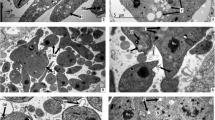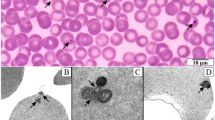Summary
The fine structure of trophozoites and especially of merozoites of Babesia herpailuri is described before and after treatment with Imidocarb® (Wellcome). The mostly piriform to oval merozoites possess an outer membrane and a supporting membrane below. The intratorium consists of a polar ring, rhoptries micronemes and the spherical body which lies beside the big nucleus and next to mitochondria. The endoplasmic reticulum and invaginations are not clearly formed.
The cellular changes of Babesia herpailuri, observed one hour after drug treatment in trophozoites and six hours later in merozoites, concern the form and function of the parasite: widening of the subpellicular endoplasmic reticulum and of the perinuclear space; sporadic dilatation of the endoplasmic reticulum of the merozoites (9 fig.). Damaged membranes, dissolution of the cellular membrane, disintegration of the nuclei as are known effects of the Berenil treatment to Babesia herpailuri, are not noted results after the Imidocarb treatment. The original membrane systems of trophozoites as well as of merozoites, remain unaffected by the drug as long as investigations were carried on (24 h).
The satisfying prophylactic effect of Imidocarb as well as the insignificant cellular damages on merozoites may be due to the small feeding of hemoglobin.
Zusammenfassung
Ziel der vorliegenden Arbeit ist die Darstellung der feinstrukturellen Veränderungen von Babesia herpailuri in Erythrozyten der Hauskatze nach Behandlung mit Imidocarb® (3,3′-bis-2-imidazolin-2-yl)-carbanilid. Im Zusammenhang mit der Frage nach der Wirkungsweise des Chemotherapeutikums bedurfte es der Untersuchung von Vorhandensein und Morphologie der Merozoiten des Parasiten. Die vorwiegend piriformen bis ovalen Merozoiten von Babesia herpailuri besitzen eine Elementarmembran und eine unter dieser liegende Stützmembran. Polring, Rhoptrien, Mikronemen und sphärischer Körper, der seitlich neben dem großen Kern und in der Nähe der Mitochondrien liegt, bilden das Intratorium. Endoplasmatisches Retikulum und Invaginationen sind zumeist schwach ausgebildet.
Die beobachteten Zellveränderungen an Babesia herpailuri (erstmals 60 min nach Therapiebeginn an den Trophozoiten und nach 6 h an den Merozoiten) betreffen Form und Funktion des Parasiten:
Ausweitung der Schläuche des subpellikulären endoplasmatischen Retikulums und des Kernspaltes der Trophozoiten; sporadische Erweiterung des ER im Zellinneren der Merozoiten. Membranschäden, Auflösung der Zellmembran oder der Zellkerne analog der Exposition von B. herpailuri in Berenil, erfolgen nach Imidocarb-Behandlung weder an Trophozoiten noch an Merozoiten. Das ursprüngliche Membransystem beider Parasitenstadien bleibt während des Verfolgungszeitraumes von 24 h erhalten. Der Wirkungsmechanismus des Imidocarb, auch hinsichtlich seiner prophylaktischen Wirkung, wird diskutiert.
Similar content being viewed by others
Literatur
Adams, L. G., Todorovic, R. A.: The chemotherapeutic efficacy of imidocarb dihydrochloride on concurrent bovine anaplasmosis and babesiosis. The effects of a single treatment. Trop. Anim. Hlth Prod. 6, 71–78 (1974)
Adams, L. G., Todorovic, R. A.: The chemotherapeutic efficacy of imidocarb dihydrochloride on concurrent bovine anaplasmosis and babesiosis. The effects of multiple treatments. Trop. Anim. Hlth Prod. 6, 79–84 (1974)
Aikawa, M.: The fine structure of the erythrocytic stages of three avian malarial parasites, Plasmodium fallax, P. lophurae and P. cathemerium. Amer. J. trop. Med. Hyg. 15, 449–471 (1966)
Beveridge, E.: Babesicidal effects of basically substituted Carbanilides. II. Imidocarb in rats and mice: toxicity and activity against Babesia rodhaini. Res. vet. Sci. 10, 534–539 (1969)
Davies, E., Warhurst, D., Peters, W.: The chemotherapy of rodent malaria. XXI. Action of quinine and WR 122, 455 (9-9-phenanthrenemethanol) on the fine structure of Plasmodium berghei in mouse blood. Ann. trop. Med. Parasit. 69, 147–153 (1975)
Dennig, H. K.: Vergleichende Untersuchungen über die Babesien tropischer Feliden unter besonderer Berücksichtigung einer neuen Species. Habil.-Schrift, München (1968)
Dennig, H. K., Hebel, R.: Ultrastructural alterations of Babesia herpailuri following treatment with Acaprin®. Proc. III. Int. Congr. Parasit. Munich 1, 61–62 (1974)
Dykstra, W., Meszoely, Ch.: Morphological changes caused by quinine on the intraerythrocytic stages of Plasmodium lophurae. 28. Ann. Meeting Soc. Protozool., Corvallis/Oregon 1975, ref. in: J. Protozool. 22, 17A (1975)
Friedhoff, K., Scholtyseck, E., Weber, G.: Die Feinstruktur der differenzierten Merozoiten von Babesia ovis in den Speicheldrüsen weiblicher Zecken. Z. Parasitenk. 38, 132–140 (1972)
Hebel, R., Dennig, H. K.: Licht- und elektronenmikroskopische Untersuchungen an Babesia herpailuri nach Behandlung mit 4-4′-Diamidino-Diazoamino-Benzol (Berenil®). Z. Parasitenk. 33, 1–20 (1969)
Howells, R., Peters, W., Fullara, J.: The chemotherapy of rodent malaria. XIII. Fine structural changes observed in the erythrocytic stages of Plasmodium berghei following exposure to primaquine and menoctone. Ann. trop. Med. Parasit. 64, 203–207 (1970)
Howells, R., Peters, W., Thoma, E.: The chemotherapy of rodent malaria. III. Host-parasite relationships, part 3: The relationships between haemozoin formation and the age of the host cell. Ann. trop. Med. Parasit. 62, 267–270 (1968)
McHardy, N., Simpson, R.: Imidocarb diproprionate therapy in Kenyan anaplasmosis and babesiosis. Trop. Anim. Hlth Prod. 6, 63–70 (1974)
Miller, L., Aikawa, M., Dvorak, J.: Malaria (Plasmodium knowlesi) merozoites: Immunity and the surface coat. J. Immunol. 114, 1237–1242 (1975)
Peters, W.: The chemotherapy of rodent malaria. II. Host-parasite relationships, part 2: The relationship between chloroquine sensitivity and the age of the host cell. Ann. trop. Med. Parasit. 62, 246–251 (1968)
Reynolds, E.: The use of lead citrate at high pH as an electron opaque stain in electron microscopy. J. Cell Biol. 17, 208–212 (1963)
Roy-Smith, F.: The prophylactic effects of imidocarb against Babesia argentina and Babesia bigemina infections in cattle. Aust. Vet. J. 47, 418–420 (1971)
Schmidt, G., Hirt, R., Fischer, R.: Babesicidal effect of basically substituted Carbanilides. I. Activity against Babesia rodhaini in mice. Res. Vet. Sci. 10, 530–533 (1969)
Scholtyseck, E., Mehlhorn, H.: Ultrastructural study of characteristic organells (paired organells, micronemes, micropores) of Sporozoa and related organisms. Z. Parasitenk. 34, 97–127 (1970)
Scholtyseck, E., Mehlhorn, H., Friedhoff, K.,: The fine structure of the conoid of Sporozoa and related organisms. Z. Parasitenk. 34, 68–94 (1970)
Simpson, Ch., Kirkham, W., Kling, J.: Comparative morphologic features of Babesia caballi and Babesia equi. Amer. J. vet. Res. 28, 1693–1697 (1967)
Theakston, R., Fletcher, K., Maigraith, B.: The fine structure of Plasmodium vinckei, a malaria parasite of rodents. Ann. trop. Med. Parasit. 62, 122–134 (1968)
Todorovic, R., Vizcaino, O., Gonzalez, E., Adams, L.: Chemoprophylaxis (Imidocarb) against Babesia bigemina and Babesia argentina infections. Amer. J. vet. Res. 34, 1153–1161 (1973)
Weber, G., Friedhoff, K.: Lichtmikroskopische Untersuchungen über die Entwicklung von Babesia ovis (Piroplasmidea) in Rhipicephalus bursae (Ixodoidea). II. Cytochemische Untersuchungen an differenzierten Merozoiten in den Speicheldrüsen weiblicher Zecken. Z. Parasitenk. 35, 218–233 (1971)
Wood, J.: The activity of Imidocarb against Babesia infections of cattle. Ir. Vet. J. 25, 254–257 (1971)
Author information
Authors and Affiliations
Additional information
Herrn Professor Dr. J. Bloch zum 60. Geburtstag gewidmet
Rights and permissions
About this article
Cite this article
Göbel, E., Dennig, H.K. Die Ultrastruktur der Trophozoiten und Merozoiten von Babesia herpailuri in Erythrozyten der Hauskatze nach Behandlung mit Imidocarb® (3,3′-bis-2-imidazolin-2-yl)-carbanilid. Z. F. Parasitenkunde 49, 97–112 (1976). https://doi.org/10.1007/BF00382417
Received:
Issue Date:
DOI: https://doi.org/10.1007/BF00382417




